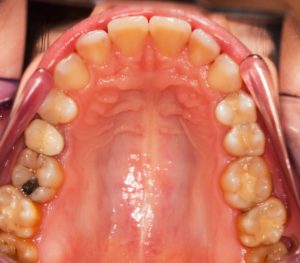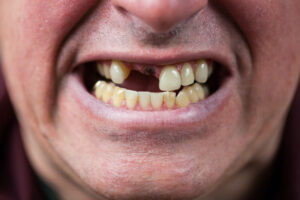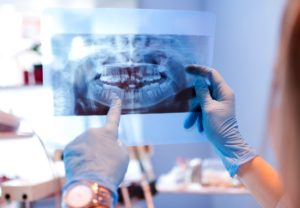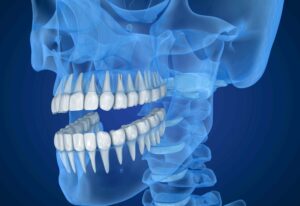Header logo
header top contact widget
periodontal plastic surgery
A Periodontist Can Contour Gum Tissues For A More Beautiful Smile
Posted on Nov 23, 2023 by William J. Claiborne, DDS MS
During the holidays, my wife and I attend gatherings where we occasionally meet new people. A common question, as applies to most of us, is “What do you do?” When I reply that I’m a periodontist, it is often met with a look of not knowing what a periodontist is but not wanting to appear as if that’s the case.
I’d like to explain what “we” are and, from a smile enhancement basis, what we can provide. I typically find that when I say “periodontal plastic surgery” it comes across as far more familiar than “performing gingivectomies.”
A periodontist is a dental specialist who has an advanced level of understanding when it comes to diseases of the oral tissues, reshaping of gum tissues and in the selection and placement of dental implants.
The American Academy of Periodontology defines a Periodontist as:
“A periodontist is a dentist who specializes in the prevention, diagnosis, and treatment of periodontal disease, and in the placement of dental implants. Periodontists are also experts in the treatment of oral inflammation. Periodontists receive extensive training in these areas, including three additional years of education beyond dental school. They are familiar with the latest techniques for diagnosing and treating periodontal disease, and are also trained in performing cosmetic periodontal procedures.”
https://www.perio.org/consumer/what-is-a-periodontist
To reach this specialty begins with educational requirements that are extensive. First, there is completion of 4 years of college (for an undergraduate degree) followed by another 4 years in dental school (for a doctorate). To specialize in Periodontics, he or she must further their education for another 3-4 years before completing the stringent requirements for specialty certification in periodontics.
The gums are rather under-rated when it comes to the tremendous role they play in both oral health and even your overall health.
Think of the gum tissues as a protective blanket in the mouth. The gums cover over the structures that support teeth and house the tissues and bone that are vital to our health. For instance, look at the base of each tooth. You’ll see that gum tissues snugly wrap around the base of each tooth. This protective seal is what prevents bacterial penetration beneath the gum line.
When oral bacteria amass to an extent that cannot be controlled by oral hygiene measures at home, they cause inflammation in the gums. In turn, the gums loosen their tight grip around teeth, which allows entry of the now-potent bacteria. These infectious bacteria have been linked to a number of problems related to a long list of serious health problems.
Oral bacteria has been found to trigger or worsen systemic conditions, including atherosclerotic vascular (heart) disease, pulmonary (respiratory) disease, diabetes, pregnancy-related complications (including preterm births), osteoporosis (bone loss), and kidney disease. A shared trait between gum disease and these medical conditions is that they are chronic conditions that take a long time to develop.
https://www.agd.org/docs/default-source/self-instruction-(gendent)/gendent_nd17_aafp_kane.pdf
It is important to be familiar with the signs and symptoms of periodontal (gum) disease, which include:
• Red, swollen or tender gums
• Bleeding while brushing, flossing, or when eating certain foods
• Gums that pull away from the teeth (recede) or make the teeth appear longer than normal
• Loose or separating teeth
• Pus pockets that form between gums and teeth
• Sores in your mouth
• Persistent bad breath
• A change in the way teeth fit together when biting
• A change in the fit of partial dentures
If you have any of these, you are urged to seek a thorough periodontal evaluation as soon as possible. This disease will only worsen without treatment. Gum disease is the nation’s leading cause of adult tooth loss.
Healthy gum tissues do more than serve in a protective role. The appearance of a smile can be greatly affected by the shape and amount of gum tissues exposed when smiling.
When a smile shows too much or too little gum tissue bordering the tops of teeth, it moves the “smile line” out of balance. For example, in a beautiful smile, the arches of gum tissues visible in a full smile flow at a similar height. These gum arches are in a complimentary line to teeth, rather than at varying levels over teeth. When the gum lime is not evenly balanced, it causes a smile to have a jumbled look.
Crown lengthening is performed to reposition the gum tissues to enhance the appearance of a smile. In addition to creating a more appealing look, crown lengthening is also performed to restore the tight seal of protection around teeth. While you enjoy the beauty of your new smile, crown lengthening gives your oral health a boost at the same time.
When the height of gum tissues that show above all teeth in a smile is too high, it is referred to as a “gummy smile.” A gummy smile is not detrimental to your oral health. However, having one does affect the appearance of a smile based on balance. For some people, it makes them “hold back” on a full smile.
This can be corrected with a gingivectomy. To begin, we numb the gum tissues and carefully trim the excess. As a Periodontist, I take specific measures to ensure a natural looking arch remains over the teeth while preserving the natural points that ‘dip’ between each tooth.
 A gingivectomy is performed in our Asheville periodontal office with a dental laser. This provides patients with a number of advantages: (1) enhanced comfort; (2) precision lines; (3) minimal or no bleeding; and, (4) faster healing time.
A gingivectomy is performed in our Asheville periodontal office with a dental laser. This provides patients with a number of advantages: (1) enhanced comfort; (2) precision lines; (3) minimal or no bleeding; and, (4) faster healing time.
In our Asheville NC periodontal office, we use the highly-advanced LANAP with PerioLase MVP 7 Laser-Assisted Attachment Procedure. This is an advanced protocol that efficiently and effectively treats advanced gum disease (periodontitis) with the added advantages of a dental laser. It is a non-surgical alternative for patients with moderate to severe periodontal disease, causes very little discomfort and has a quick recovery time. It has also been found to stimulate bone regrowth in damaged areas.
In some cases, the crown lengthening procedure can save a tooth from removal. Typically, when a tooth fractures or breaks at the gum line, it must be removed since there is not enough tooth structure to support a crown. However, a crown lengthening procedure may be able to expose more of the tooth’s structure, essentially saving the natural tooth.
For those who have avoided gum treatment due to dental fear, we offer several sedation options, including oral and IV sedation. Oral sedation is a pill that helps patients relax. It also has an amnesiac effect, leaving most with little or no memory of treatment afterward.
I.V. sedation (also known as “twilight sleep”) places the patient in a deeper sleep state and erases memory of the procedure. Here, anesthesia is overseen by a medical doctor (MD) who is a board certified Anesthesiologist. With both sedation options, patients are closely monitored with advanced safety equipment throughout treatment.
We help patients understand that their fears and concerns are not unusual. The doctors and staff of our Asheville periodontal dental office respect each patient and provide gentle, compassionate care – at every appointment.
We believe you’ll find no better periodontal dental environment in western NC. Whatever your need for the treatment of gum disease, recontouring of gum tissues, or in the placement of dental implants, call 828-274-9440 to learn more or to schedule a consultation appointment. New patients are always welcome and a referral is not required.
Laser Dentistry, Cone Beam Imaging Among Our Advanced Features!
Posted on Nov 15, 2023 by William J. Claiborne, DDS MS
Like your “adult” teeth, your gum tissues are irreplaceable. Without question, they deserve the care and attention that come with keeping them healthy and doing their job.
Gum tissues are designed to protect the structures underneath. These include bones, tooth roots, tendons, and muscles to prevent entry of harmful bacteria. Gums are designed to snugly wrap the base of each tooth to keep bacteria from penetrating sensitive root segments of teeth.
Without this protective seal around teeth, the potential for periodontal (gum) disease greatly increases. And gum disease is at concerningly high levels in the U.S. with an estimated 47% of adults having some level of gum disease.
I believe that this high level of gum disease is largely in part due to Americans not being fully familiar with the symptoms. Some are easily ignored or “brushed off” as normal. This is why it is important to be familiar with the signs and symptoms, which include:
• Red, swollen or tender gums or other pain in your mouth
• Bleeding while brushing, flossing, or when eating certain foods
• Gums that pulling away from the base of teeth, making them appear teeth longer
• Loose or separating teeth
• Pus between your gums and teeth
• Sores in your mouth
• Persistent bad breath
• A change in the way your teeth fit together when biting
• A change in the fit of partial dentures
If you are experiencing any of these symptoms, you are urged to seek care with a periodontal specialist as soon as possible. This disease will only worsen without treatment.
Why should you be concerned about periodontal disease?
Gum disease is the nation’s leading cause of adult tooth loss. Additionally, research has linked the bacteria of periodontitis with serious health problems. These include heart disease, stroke, arthritis, diabetes, some cancers, preterm babies, erectile dysfunction (ED) and high blood pressure. Studies on links to Alzheimer’s disease are showing concerning correlations.
A periodontist is an expert in the treatment of all stages of gum disease, including gingivitis, periodontal disease, and the advanced form of periodontitis.
In addition to having these specific skills, I’d like to share the benefits of some of our amazing technology we make available to our Western NC patients. One with a wide range of benefits to patient care is our Dental Laser.
Nd: YAG Dental Laser: This is a small, hand-held device that eliminates or greatly minimizes bleeding during procedures. It also reduces numbing requirements, removes bacteria and easily uncovers gum tissue where dental implants have been placed.
Additionally, laser dentistry can quickly repair oral ulcers and beautifully re-contours or repairs gum tissue with a precision line. Some specific treatments that are ideal for a dental laser include:
Canker & Cold Sores: The laser is also ideal for rapid healing of canker and cold sores. Laser therapy can halt the progression of canker sores, reducing the pain in a day or so. Otherwise, they can last up to 2 weeks. When it comes to cold sores, they are best treated with our laser when the very first symptom arises. Tingling or burning sensation is the first sign that a cold sore is about to erupt. Although lasers can still treat these lesions in later stages, the treatment is most effective in initial stages. Most patients notice significant improvement in comfort after laser treatment with a much shorter duration.
Gum Disease Treatment: In our office, we also use a dental laser to destroy the bacteria of gum disease. This technology also speeds the process and heightens your comfort, saving you treatment time with faster healing.
Correcting a “Gummy Smile”: This is when a smile shows too much gum tissue above upper teeth when smiling fully. We correct this in a procedure known as crown lengthening. In this, a gingivectomy adjusts the height of gum tissues so the smile has a more even smile line. This may involve the use of a dental laser, which provides a precision line and speeds healing.
Balancing a smile line: A gingivectomy is also advised to rebalance the frame of gum tissues that arch the teeth visible in a smile. When one or two teeth have different heights of gum tissue, the smile has a jumbled look. A dental laser can even out the smile line and enhance the beauty of a smile.
Saving a tooth broken near the gum line: When a tooth breaks at or near the gum line, it often requires removal. In some cases, however, we can save the tooth by exposing enough of the structure to receive a crown. This helps the patient to avoid removal and thereby preserves the supporting jaw bone.
In our Asheville NC periodontal dental office, we feature additional technologies, some of the most advanced in the industry. These include:
LANAP Protocol Using PerioLase MVP-7: This process is designed to efficiently and effectively treat periodontitis (advanced gum disease) through laser technology. Treatment is administered with minimal (or no) discomfort and recovery time is minimal. Amazingly, this technology has also been able to stimulate bone regrowth in damaged areas.
Cone Beam 3D Imaging: These views allow us to see your jaw in 3D dimensions and to be able to view it at varying angles. This enables us to see what used to be hidden from view.
Cone Beam images are often used to assess:
• Dental Implant Positions
• Temporomandibular Joints (TMJ)
• Airway Passages
• Bone Structure Damage or Bone Loss
• Teeth, Tooth Roots and Facial Structures
• Signs Of Infections, Cysts, Or Tumors
CS 3600 Intraoral Scanner: Through this process, our patient no longer have impressions made with bulky, goopy trays held in their mouths. This technology quickly and comfortably scans the mouth’s interior for digital impressions using a small, handheld scanner. It can also reach difficult–to–access areas in the patient’s mouth with improved patient comfort.
Simplant Dental Software for Computerized Dental Implant Placement: This system helps in pre-surgical positioning of dental implants on the computer, using a 3D model of the patient’s jaw. This aids in the selection of the implant type to ensure a precision fit.
Intraoral Camera Technology: This provides outstanding quality of images within the mouth. These images are sent to screen for a clear, crisp view so we can confer with patients on specific treatment needs.
Computer Imaging In Treatment Suites: Treatment suites are equipped with computers for convenient image sharing with patients.
Oral & IV Sedation: We take patient comfort very seriously in our Asheville periodontal dental office. That’s a commitment we make to every patient at every appointment. Here, patient comfort is supported by our sedation options. These include oral and I.V. sedation. Also referred to as “twilight sleep” or “sleep dentistry,” these sedatives are administered by a highly-skilled anesthesiologist who uses advanced safety monitoring equipment throughout the patient’s procedure.
My staff and I also take great pride in providing patients with an environment of respect. Some adults come to us embarrassed by the condition of their oral health or missing teeth. Here, we strive to make patients feel they are in the right hands in the right place.
If tooth loss has occurred, a periodontist also specializes in the selection and placement of all types of dental implants. Dental implants, for many reasons, are the preferred option for tooth replacement.
Call 828-274-9440 to schedule a consultation in our state-of-the-art Asheville periodontal dental office. New patients are always welcome and a referral is not always necessary.
Missing Teeth? HOW You Replace Them Will Make the Biggest Difference.
Posted on Oct 23, 2023 by William J. Claiborne, DDS MS
I remember a time when people assumed they would lose their natural teeth as they aged. Wearing full dentures in one’s senior years was almost an expectation. However, today’s adults are less accepting of “false teeth.”
Over time, adults have learned that the removal of a natural tooth has lasting repercussions. Although the tooth may have been removed because of decay or a break, the long list of problems and associated expenses are generally far greater than what was anticipated. I’ll explain.
When a natural tooth is removed, its absence causes a reaction that begins below the gum line. Without the presence of tooth roots, the bone begins to “melt.” This process is known as resorption.
The absence of a tooth root in the upper or lower jaw bone removes stimulation to the bone mass where it was once positioned. Along with the stimulation, natural tooth roots channel nourishment needed for maintaining a healthy mass.
Resorption begins shortly after the tooth root is removed. Once it starts, it continues at an ever-increasing pace. For example, the first year after a tooth root is missing, the loss of bone may be minimal. With each passing year, the pace of loss accelerates. For people who sleep with their dentures, the 24/7 pressure on the gum ridge speeds up the pace even more.
As the bone shrinks in height, the natural tooth roots adjacent to the area of missing teeth are subject to movement and root damage. On average, the next teeth you’re most likely to lose are the ones bordering areas of missing teeth.
Obviously, it is important to replace lost teeth before bone loss begins. For the support of remaining natural teeth, it’s also important to replace missing teeth as soon as possible so adjacent teeth can retain their proper positions. Yet, merely replacing the presence of a tooth above the gum line leaves the underlying risk factors in place. Over time, problems arise for most individuals.
There are many reasons we recommend dental implants for tooth replacement, whether for one, several or a full mouth of missing teeth. Dental implants recreate stimulation to the jaw bone, thereby halting the pace of bone loss. When bone mass is maintained, neighboring teeth have a reduced risk for being lost as well.
Because dental implants are held in the jaw bone, they are able to restore a natural biting strength with dependable stability. Having the ability to bite and chew efficiently and enjoy a diet of foods you love enhances eating pleasure and proper digestion. It’s no surprise that people who wear dentures have more gastrointestinal problems than those who have their natural teeth.
Another advantage to dental implants is their longevity. When dental implants are properly selected, placed and maintained, they should last your lifetime. This is why it’s so important to have your implant treatment through a Periodontist.
A periodontal specialist has advanced training to properly diagnose and place the most appropriate dental implant system for your needs and goals. As an Asheville periodontist with over 30 years of experience in dental implants, I have a reputation for treatment that provides the most successful outcome based on each patient’s unique needs – and by the most conservative means possible. Thus, the patient avoids having more time and expense involved than is necessary.
We are also known for providing a high level of patient comfort through the administration of IV sedation (twilight sleep) with our on-site Board Certified Anesthesiologist. Additionally, diagnosis and treatment planning is backed by images from our on-site 3D Cone Beam imaging.
Our Western NC periodontal office is fully prepared for the placement of dental implants. We tend to our patients in an efficient and effective manner so treatment occurs in minimal time and to an exceptional level of comfort.
We receive many patients who have been referred by their physician, dentist, and past/present patients, often because of our advanced skills and the respectful environment we provide. Here, each patient is treated with the same respect, compassion and gentle hands that we would want for ourselves and our loved ones. We take great pride in knowing our patients experience the finest periodontal and implant care in the Southeastern U.S.
A periodontist is a dental specialist who is trained to understand the intricate concepts involved in selecting the proper type of implant and skilled at placing implants at proper depths and angles. A periodontist is also able to optimize patient comfort during treatment and throughout the healing phase.
In addition to this advanced training, our office offers some of the most advanced technology available. This aids in the diagnosis and treatment planning of dental implants, providing patients with optimized comfort and outcomes. This technology, combined with our advanced skill level, creates a comfortable, efficient experience that helps you enjoy a lifetime of confident smiles.
Dental implants are also designed to last a lifetime. I can think of very few things that provide this kind of value. With proper selection and maintenance, they will never need replacing or repair, making them an excellent investment.
If you are considering dental implants, increase your potential for a successful outcome by asking a Periodontist to join your dentist in team treatment. Most general dentists have close relationships with periodontal specialists for implant placement, gum reshaping and in the treatment of gum disease.
If you have lost natural teeth or are facing the potential of tooth removal, call 828-274-9440 to schedule a consultation. This will occur in a private, comfortable consultation room conveniently located in our Asheville periodontal dental office. During this time, we’ll discuss the implant systems that may work best for your needs and preferences. I’ll explain the treatment involved, sedation options and estimated fees.
Six Reasons To Have Your Dental Implants Placed By A Periodontist
Posted on Jul 12, 2023 by William J. Claiborne, DDS MS
A periodontist is a dental specialist who is often in the background of various dental procedures. Yet, we are in the forefront when it comes to specialized skills that support specific treatment needs.
 Most patients are referred to our Asheville periodontal dental office by general dentists and dental specialists to provide certain aspects of dental treatment, which may involve our skills in cosmetic dentistry, dental implants, and treating all stages of gum disease.
Most patients are referred to our Asheville periodontal dental office by general dentists and dental specialists to provide certain aspects of dental treatment, which may involve our skills in cosmetic dentistry, dental implants, and treating all stages of gum disease.
A periodontist has advanced training to properly diagnose and treat all stages of periodontal (gum) disease (including gingivitis and periodontitis) as well as placement of dental implants. In addition, periodontists are particularly skilled in performing cosmetic periodontal procedures to repair gum-related disparities such as a “gummy smile” or varying gum arches that “jumble” a smile line.
A periodontist receives an additional 3 years of training after 4 years of undergraduate school and 4 years of dental school. This long, rigorous pursuit of the periodontal specialty requires the individual to be highly committed to the advanced care he or she will provide. It is our goal to help people achieve good oral health, a confident smile they love to share, and prevent tooth loss that can result from diseases of the gums.
Dental implants are now seen as the preferred option for tooth replacement. They come in over 40 different types designed to accommodate various challenges and preferences. But, why should you have your dental implants chosen and placed by a periodontist? After all, some dentists perform this in addition to their general dentistry services.
Below are 6 reasons our dental implant patients have particular advantages…
(1). With specialized skills, a periodontist is especially respectful to oral tissues as sensitive layers that have an important role in the appearance of a smile and the health of teeth. Utilizing these skills, a periodontist can help to minimize incisions while effectively treating each area in the mouth.
(2). Rather than be limited to just one or two dental implant systems that were taught in a “crash course” by the implant manufacturers, our speciality understands the complete spectrum of implant systems. Some may be ideal for your needs while others may not. Some provide you with a non-removable (“fixed”) option while others may involve removable teeth. Our specialized skills give you the best choices you should have.
(3). Additionally, the proper selection of your dental implants may greatly save you in treatment fees. For example, the All-On-4 dental implant system needs only 4 implants per arch, and can be placed in shallow bone. The treatment fees are less since the number of implants is low and the need for bone regeneration for severe bone loss may not be required. For these reasons, a periodontist may be able to help you achieve your tooth replacement goals within a budget you can manage.
(4). In our Western NC periodontal dental office, our advanced technology includes 3-D Cone Beam Imaging. This is ideal for diagnoses and treatment planning through images that provide a clear view of the upper and lower jaw (including nerve canals), with rotations that show sagittal, axial, and coronal planes. The imaging process is quick, painless and at minimal radiation levels.
(5). Another feature is our Computerized Dental Implant Placement system. This advanced technology is designed for pre-surgical positioning of dental implants that uses a 3D model of the patient’s jaw. Once the implant type is selected, a template is developed for optimal treatment success, even for complex cases. This minimizes disruption of gum tissues and targets implant placement at ideal depths and angles. Thus, treatment success rates are higher with faster (and more comfortable) healing time.
(6). Optimal comfort for our patients has always been a priority. For many, a desired level of comfort and relaxation includes sedation options. Here, we offer several sedation options, including oral and IV sedation.
Oral sedation is a pill that helps patients relax. It also has an amnesiac effect, leaving most with little or no memory of treatment afterward. IV sedation (also known as “twilight sleep”) places the patient in a deeper sleep state and erases memory of the procedure. It is administered by a Medical Doctor (MD) who is a board certified Anesthesiologist.
With both sedation options, patients are closely monitored with advanced safety equipment throughout treatment.
If you are considering dental implants, you may wish to begin with a consultation appointment. During this time, we can explain the vast difference in comfort, treatment time, and success available through our specialized skills and extensive technology.
Call 828-274-9440 to schedule. New patients are always welcome and a referral is not always required.
Recent Posts
Categories
Archives
- September 2024
- August 2024
- July 2024
- June 2024
- May 2024
- April 2024
- March 2024
- February 2024
- January 2024
- December 2023
- November 2023
- October 2023
- September 2023
- August 2023
- July 2023
- June 2023
- May 2023
- April 2023
- March 2023
- February 2023
- January 2023
- December 2022
- November 2022
- October 2022
- September 2022
- August 2022
- July 2022
- June 2022
- May 2022
- April 2022
- March 2022
- February 2022
- January 2022
- December 2021
- November 2021
- October 2021
- September 2021
- August 2021
- July 2021
- June 2021
- May 2021
- April 2021
- March 2021
- February 2021
- January 2021
- December 2020
- November 2020
- October 2020
- September 2020
- August 2020
- July 2020
- June 2020
- May 2020
- April 2020
- March 2020
- February 2020
- January 2020
- December 2019
- November 2019
- October 2019
- September 2019
- August 2019
- July 2019
- June 2019
- May 2019
- April 2019
- March 2019
- February 2019
- January 2019
- December 2018
- November 2018
- October 2018
- September 2018
- August 2018
- July 2018
- June 2018
- May 2018
- April 2018
- March 2018
- February 2018
- January 2018
- December 2017
- November 2017
- October 2017
- September 2017
- August 2017
- July 2017
- June 2017
- May 2017
- April 2017
- March 2017
- February 2017
- January 2017
- December 2016
- November 2016
- October 2016
- September 2016
- August 2016
- July 2016
- June 2016
- May 2016
- April 2016
- March 2016
- February 2016
- January 2016
- December 2015
- November 2015
- October 2015
- September 2015
- August 2015
- July 2015
- June 2015
- May 2015
- April 2015
- March 2015
- February 2015
- January 2015
- December 2014
- November 2014
- October 2014
- September 2014
- August 2014
- July 2014
- June 2014
- May 2014
- April 2014
- March 2014
- February 2014
- January 2014
- December 2013
- November 2013
- October 2013
- September 2013
- August 2013
- July 2013
- June 2013
- May 2013
- April 2013
- March 2013
- February 2013
- January 2013
- December 2012
- November 2012
- October 2012
- September 2012
- August 2012
- July 2012
- June 2012


